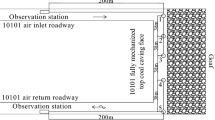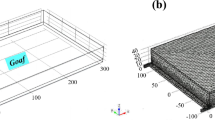Abstract
To prevent coal spontaneous combustion in mines, it is paramount to understand O2 gas distribution under condition of inert gas injection into goaf. In this study, the goaf was modeled as a 3-D porous medium based on stress distribution. The variation of O2 distribution influenced by CO2 or N2 injection was simulated based on the multi-component gases transport and the Navier–Stokes equations using Fluent. The numerical results without inert gas injection were compared with field measurements to validate the simulation model. Simulations with inert gas injection show that CO2 gas mainly accumulates at the goaf floor level; however, a notable portion of N2 gas moves upward. The evolution of the spontaneous combustion risky zone with continuous inert gas injection can be classified into three phases: slow inerting phase, rapid accelerating inerting phase, and stable inerting phase. The asphyxia zone with CO2 injection is about 1.25–2.4 times larger than that with N2 injection. The efficacy of preventing and putting out mine fires is strongly related with the inert gas injecting position. Ideal injections are located in the oxidation zone or the transitional zone between oxidation zone and heat dissipation zone.















Similar content being viewed by others
Abbreviations
- A :
-
Pro-factor
- a 0 :
-
Attenuation rate in the tendency direction
- a 1 :
-
Attenuation rate in the srike direction
- b 0, b 1 :
-
Adjusting parameters
- C :
-
Mass concentration
- D :
-
Diffusivity (m2s−1)
- E :
-
Activation energy (kJ/mol)
- \( \overrightarrow {g} \) :
-
Vector of gravity (ms−2)
- H :
-
Height (m)
- \( K \) :
-
Coefficient of rock dilatation
- \( K_{p,\hbox{max} } \) :
-
Initial caving coefficient
- \( K_{p,\hbox{min} } \) :
-
Coefficient of bulk increase
- k :
-
Permeability (m2)
- \( k_{0} \) :
-
Base permeability (m2)
- L :
-
Length (m)
- \( \dot{m} \) :
-
Mass generation rate (kg/m3s)
- \( P \) :
-
Pressure (N/m2)
- R :
-
Ideal gas constant
- \( S \) :
-
Source term
- T :
-
Temperature (K)
- \( t \) :
-
Time (s)
- \( \varvec{u} \) :
-
Velocity vector
- \( u,\,v,\,w \) :
-
Velocity components (m/s)
- W :
-
Width (m)
- x, y, z :
-
Spatial coordinates
- \( \alpha \) :
-
Reaction constant
- \( \varepsilon \) :
-
Adjusting parameter
- ξ:
-
Porosity
- μ:
-
Dynamic viscosity [kg/(m s)]
- ρ:
-
Density of the gas mixture (kg/m3)
- i :
-
Gas component
References
Krishnaswamy S, Agarwal PK, Gunn RD (1996) Low-temperature oxidation of coal. 3. Modeling spontaneous combustion in coal stockpiles. Fuel 75:353–362
Li X (1998) Coal mine safety in China. China Coal Industry Press, Beijing
Hofgren H, Sunden B (2015) Evaluation of Planck mean coefficients for particle radiative properties in combustion environments. Heat Mass Transf 51:507–519
Achim D, Naser J, Morsi YS, Pascoe S (2009) Numerical investigation of full scale coal combustion model of tangentially fired boiler with the effect of mill ducting. Heat Mass Transf 46:1–13
Wang H, Dlugogorski BZ, Kennedy EM (2003) Coal oxidation at low temperatures: oxygen consumption, oxidation products, reaction mechanism and kinetic modeling. Prog Energy Combust Sci 29:487–513
Deng J, Xu J, Li L (2001) Experimental investigation on the relationship of oxygen consumption rate of coal and the concentration of oxygen. J Xiangtan Min Inst 3:12–18
Singh D, Croiset E, Douglas PL, Douglas MA (2003) Techno-economic study of CO2 capture from an existing coal-fired power plant: MEA scrubbing vs. O2/CO2 recycle combustion. Energy Convers Manag 44:3073–3091
Shao H, Jiang S, Wu Z (2013) Numerical simulation on fire prevention by infusing carbon dioxide into goaf. J Min Saf Eng 30(1):154–158
Li X (2003) Numerical simulation and parameter determination of nitrogen injection process in Fire prevention and Extinguishing in fully mechanized longwall top-coal goaf. China Saf Sci J 5:57–61
Zhang Y, Liu P, Li P, Huang Z, Gao Y (2013) Research on influence of injecting CO2 at goaf of 13304 caving face of Sunjiagou coal mine on its three zones of spontaneous combustion. Disaster Adv 6:341–349
Sun Y, Ma J (2015) Application of collocation spectral method for irregular convective–radiative fins with temperature-dependent internal heat generation and thermal properties. Int J Thermophys 36(10–11):3133–3152
Liang Y, Zhang T, Wang S, Sun J (2012) Heterogeneous model of porosity in gobs and its airflow field distribution. J China Coal Soc 09:1203–12037
Che Q (2010) Study on coupling law of mixed gas three-dimensional multi-field in goaf. China Univ Min Technol, Beijing
Yuan L, Smith AC (2009) CFD modeling of spontaneous heating in a large-scale coal chamber. J Loss Prev Process Ind 22(4):426–433
Wang F (2004) Computational fluid dynamics: the basics with application. Tsinghua University Press, Beijing
Qian M, Li H (1982) A study of the behaviour of overlying strata in longwall mining and its application to strata control. J China Coal Soc 7(2):1–12
Hoek E, Bray JW (1981) Rock slope engineering, revised, 3rd edn. Institution of Mining and Metallurgy, London
Creedy DP (1993) Methane emissions from coal relatedsources in Britain : development of a methodology. Energy Ind Source 26(1):419–439
Li Z, Yi G, Wu J, Guo D, Zhao C (2012) Study on spontaneous combustion distribution of goaf based on the “O” type risked falling and non-uniform oxygen. J China Coal Soc 3:484–489
Creedy DP, Clarke RDC (1992) Minimizing firedamp risks on high production coalfaces: a computational modelling approach. In: Proceedings of the international symposium: safety, hygiene and health in mining, pp 192–203
Ren T (1997) CFD modeling of methane flow around longwall coal faces. In: Proceedings of the 6th int mine ventilation congress, pp 17–22
Ren T, Edwards JS (2000) Three-dimensional computational fluid dynamics modeling of methane flow through permeable strata around a longwall face. Min Technol 109(1):41–48
ANSYS Fluent Tutorial Guide (2013). http://148.204.81.206/Ansys/150/ANSYS%20Fluent%20Tutorial%20Guide.pdf
Zhu H, Wang H, He C, Yang C (2013) Experimental of effect of oxygen concentration to coal low-temperature oxidation kinetics parameters. J Liaoning Tech Univ (Natural Science) 32:1153–1156
Wang D (2008) Mine fires. China University of Mining and Technology Press, Xuzhou
Acknowledgments
This research was supported by the National Natural Science Foundation of China (Grant Nos. 51104154 and 51134020), Central Subordinate University Basic Scientific Research Foundation (2011QNA05) and CUMT Innovation and Entrepreneurship Fund for Undergraduates (201403 and 201503).
Author information
Authors and Affiliations
Corresponding authors
Rights and permissions
About this article
Cite this article
Liu, MX., Shi, GQ., Guo, Z. et al. 3-D simulation of gases transport under condition of inert gas injection into goaf. Heat Mass Transfer 52, 2723–2734 (2016). https://doi.org/10.1007/s00231-016-1775-8
Received:
Accepted:
Published:
Issue Date:
DOI: https://doi.org/10.1007/s00231-016-1775-8




